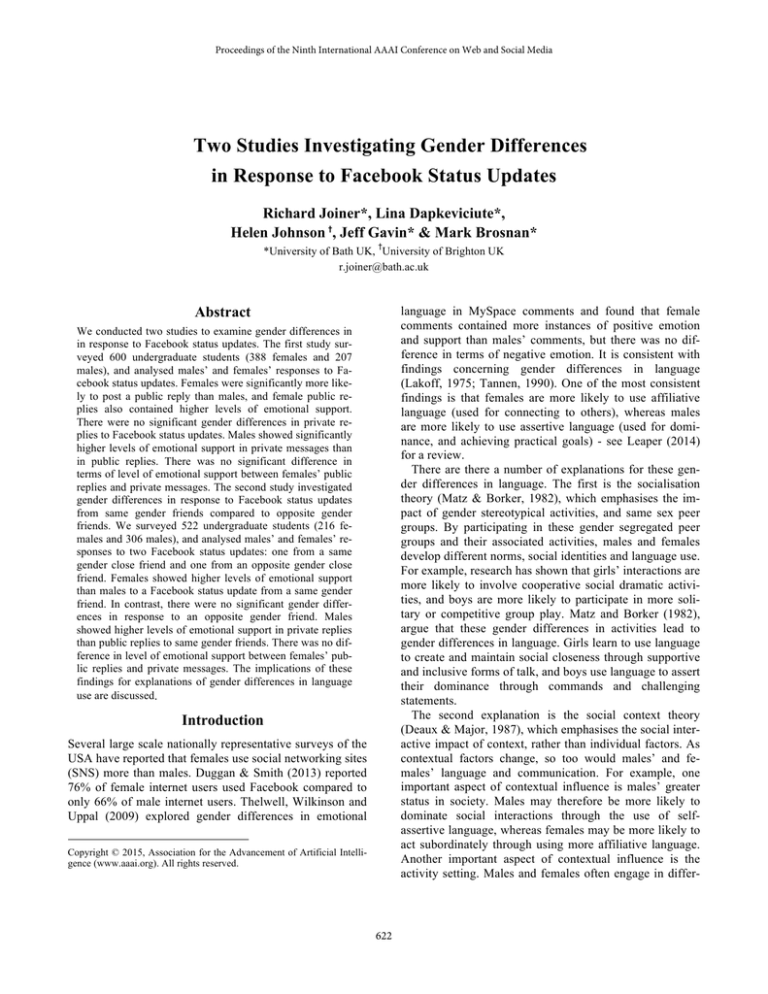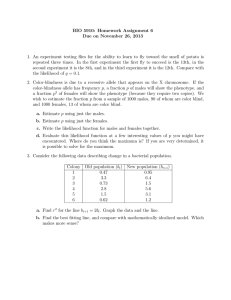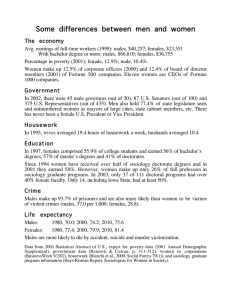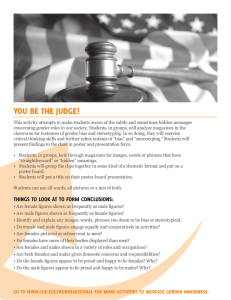
Proceedings of the Ninth International AAAI Conference on Web and Social Media
Two Studies Investigating Gender Differences
in Response to Facebook Status Updates
Richard Joiner*, Lina Dapkeviciute*,
Helen Johnson †, Jeff Gavin* & Mark Brosnan*
†
*University of Bath UK, University of Brighton UK
r.joiner@bath.ac.uk
Abstract
language in MySpace comments and found that female
comments contained more instances of positive emotion
and support than males’ comments, but there was no difference in terms of negative emotion. It is consistent with
findings concerning gender differences in language
(Lakoff, 1975; Tannen, 1990). One of the most consistent
findings is that females are more likely to use affiliative
language (used for connecting to others), whereas males
are more likely to use assertive language (used for dominance, and achieving practical goals) - see Leaper (2014)
for a review.
There are there a number of explanations for these gender differences in language. The first is the socialisation
theory (Matz & Borker, 1982), which emphasises the impact of gender stereotypical activities, and same sex peer
groups. By participating in these gender segregated peer
groups and their associated activities, males and females
develop different norms, social identities and language use.
For example, research has shown that girls’ interactions are
more likely to involve cooperative social dramatic activities, and boys are more likely to participate in more solitary or competitive group play. Matz and Borker (1982),
argue that these gender differences in activities lead to
gender differences in language. Girls learn to use language
to create and maintain social closeness through supportive
and inclusive forms of talk, and boys use language to assert
their dominance through commands and challenging
statements.
The second explanation is the social context theory
(Deaux & Major, 1987), which emphasises the social interactive impact of context, rather than individual factors. As
contextual factors change, so too would males’ and females’ language and communication. For example, one
important aspect of contextual influence is males’ greater
status in society. Males may therefore be more likely to
dominate social interactions through the use of selfassertive language, whereas females may be more likely to
act subordinately through using more affiliative language.
Another important aspect of contextual influence is the
activity setting. Males and females often engage in differ-
We conducted two studies to examine gender differences in
in response to Facebook status updates. The first study surveyed 600 undergraduate students (388 females and 207
males), and analysed males’ and females’ responses to Facebook status updates. Females were significantly more likely to post a public reply than males, and female public replies also contained higher levels of emotional support.
There were no significant gender differences in private replies to Facebook status updates. Males showed significantly
higher levels of emotional support in private messages than
in public replies. There was no significant difference in
terms of level of emotional support between females’ public
replies and private messages. The second study investigated
gender differences in response to Facebook status updates
from same gender friends compared to opposite gender
friends. We surveyed 522 undergraduate students (216 females and 306 males), and analysed males’ and females’ responses to two Facebook status updates: one from a same
gender close friend and one from an opposite gender close
friend. Females showed higher levels of emotional support
than males to a Facebook status update from a same gender
friend. In contrast, there were no significant gender differences in response to an opposite gender friend. Males
showed higher levels of emotional support in private replies
than public replies to same gender friends. There was no difference in level of emotional support between females’ public replies and private messages. The implications of these
findings for explanations of gender differences in language
use are discussed.
Introduction
Several large scale nationally representative surveys of the
USA have reported that females use social networking sites
(SNS) more than males. Duggan & Smith (2013) reported
76% of female internet users used Facebook compared to
only 66% of male internet users. Thelwell, Wilkinson and
Uppal (2009) explored gender differences in emotional
Copyright © 2015, Association for the Advancement of Artificial Intelligence (www.aaai.org). All rights reserved.
622
ent activities, which in turn have their associated patterns
of language. Affiliative language is more appropriate in
self-disclosure tasks (more commonly associated with females), and assertive language is more appropriate in task
oriented activities (more commonly associated with
males). Finally, another important aspect of context is
group size and familiarity. Deaux & Major (1987) showed
that people behave in more stereotypical ways in front of
larger and unfamiliar groups. These two explanations are
not mutually exclusive and could both explain any observed gender differences in language use.
The aim of study 1 was to examine gender differences in
language use on Facebook by analysing public and private
replies to different Facebook status updates. Public replies
to Facebook status updates could be viewed as communication in a larger group context, whereas private messages
could be viewed as communication in a small group or one
to one context with a familiar person. The socialisation
perspective, would predict that gender differences in affiliative language would be evident regardless of whether it is
a public reply or private message in response to a Facebook status update. Therefore, the study will test the following two hypotheses.
v v v exciting’. The participants were asked would they
write a public reply to the Facebook status update, and/or
send the close friend a private message. We coded the level
of emotional support expressed in the public replies and
personal messages by adapting the classification system
developed by Thelwall et al. (2009), shown in table 1.
Results
0
Absence of any supportive
elements
‘My day is probably worse
than yours’
1
Some weak supportive elements
‘What’s wrong?’
In response to the ‘Rubbish Day’ Facebook status update,
there was a significant gender difference, in terms of the
level of emotional support in public replies (t (57) = -3.43,
p < 0.005, d = 0.70). Females (M = 1.54, SD = 0.85)
showed higher levels of support than males (M = 0.98, SD
= 0.75). Similarly, for the ‘iPhone’ Facebook status update,
there was a significant gender difference in terms of the
level of emotional support in public replies (t (61) = 3.20, p
< 0.005, d = 0.85), with females (M = 0.79, SD = 0.63)
showing higher levels of support than males (M = 0.32, SD
= 0.48). In contrast, there was no significant difference
between males (M = 1.45, SD = 0.74) and females (M =
1.56, SD = 0.80) in terms of the level of emotional support
in private messages in response to the ‘Rubbish Day’ Facebook status update (t (256) = -1.26, p = 0.20, d = 0.14).
Similar findings were found for the ‘iPhone’ Facebook
status update. There was no gender difference in terms of
level of emotional support provided in private messages (t
(12) = 0.4, p = 0.4, d = 0.46), although it has to be noted
that the numbers are very small. Next, we compared the
level of emotional support in public replies compared to
private messages. Males showed significantly higher levels
of emotional support in private messages than in public
replies, (‘Rubbish day’, t (11) = 3.02, p = 0.01, d = 0.88),
whereas there was no significant difference between levels
of emotional support in female public replies and private
messages (‘Rubbish day’, t (55) = 1.11, p= .27, d = 0.14).
We did not compare the level of emotional support in male
and females’ response to the ‘IPhone’ Facebook status update, as the number of public replies and personal message
were too small
Clear supportive elements
‘What's wrong babe? :(‘
Discussion
Multiple supportive elements
‘Hey, what’s wrong? Give
me a call xxx’
Overwhelmingly supportive
elements
‘Ah what’s up? Are you
ok? Do you want to talk?
Big hugs? Xx’
H1: Females will use more affiliative language than males
when replying publically to a Facebook status update than
males.
H2: Females will use more affiliative language than males
when sending a private message to a Facebook status update than males.
Study 1
Table 1. Coding System for Levels of Support in Facebook
Status Responses.
Level
2
3
4
Label
Examples
Study 1 was designed to investigate gender differences in
public and private responses to two Facebook status updates. We found support for hypothesis 1. Females showed
significantly higher levels of emotional support in their
public replies than males, for both Facebook status updates. However we found no support for hypothesis 2.
There was no significant difference between males and
females in terms of the level of emotional support in private messages for both status updates. Thus study 1 has
found support for the social context explanation of gender
differences in language.
In study 1, we asked the participants how they would respond to a Facebook status update from a close friend, but
we did not specify whether it was a friend of the same or
Method
The study involved 600 first year undergraduate students
(388 females and 207 males), with a mean age of 19.2
(SD= 2.76). They completed a questionnaire, which was
distributed during lectures and contained two Facebook
status updates: ‘I’m having a really rubbish day’ and
‘Oooooh my iPhone has arrived! Will pick it up tomorrow
623
opposite gender. The different explanations for gender differences in language would make different predictions
concerning language in relation to a same or opposite gender friends (Carli, 1989, 1990). The socialization explanation would predict that the greatest gender language differences would arise from same-gendered friend, as both parties would follow the same behavioral norms. In contrast,
the social context explanation would predict that the gender differences would be greatest when respondents replied
to an opposite gender friend, as gender becomes a status
characteristic in mixed gender interactions (Carli, 1989,
1990).
Thus study 2 was designed to test these two conflicting
hypotheses by examining gender differences in affiliative
language when responding to a same gender close friend
compared to when responding to an opposite gender close
friend. It tested the following hypotheses.
and private messages by adapting the classification system
used in study 1 (see table 2).
Results
We first analyzed whether there were any gender differences in response to a Facebook status update from a same
gender friend. There was a significant gender difference, in
terms of the level of emotional support in public replies (t
(92) = -4.74, p < 0.005, d = 0.83). Females (M = 1.49, SD
= 0.88) showed higher levels of support than males (M =
0.28, SD = 1.46). Furthermore, there was a significant gender difference, in the level of emotional support in private
messages (t (206) = -4.06, p < 0.005, d = 0.55). Females
(M = 1.45, SD = 0.73) showed higher levels of support
than males (M = 1.02, SD = 0.80). We compared the level
of emotional support in public replies and personal messages. Males showed significantly higher levels of emotional support in private messages than in public replies, t
(10) = 3.54, p = 0.006, d = 1.45, whereas there was no significant difference between levels of emotional support in
female public replies compared with their private messages, t (17) = 0.0, p= 1, d = 0.0.
Next we analyzed whether there were any gender differences in response to a Facebook status update from an opposite gender friend. There was none, in terms of the level
of emotional support in public replies (t (76) = 0.12, p >
0.05, d = 0.03). Females (M = 1.15, SD = 0.90) showed
slightly lower levels of support than males (M = 1.18, SD
= 1.04). Furthermore, there was no gender difference, in
terms of the level of emotional support in private messages
(t (187) = 0.85, p > 0.05, d = 0.12). Females (M = 1.29, SD
= 0.57) showed lower levels of support than males (M =
1.37, SD = 0.73). Finally, we compared the level of emotional support in public replies and personal messages.
There was no significant difference between levels of emotional support in males’ public replies compared to their
private messages (t (8) = 0.20, p > 0.05, d = 0.16) and there
was no significant difference between levels of emotional
support in female public replies and personal messages, t
(14) = 0.0, p= 1, d = 0.00, although the small sample size
has to be noted.
H3: Gender differences in affiliative language when responding to a Facebook status update would be greatest
when participants were responding to a same gender friend
(socialization hypothesis).
H4: Gender differences in affiliative language when responding to a Facebook status update would be greatest
when responding to an opposite gender friend (social context hypothesis).
Study 2
Table 2. Coding System for Levels of Support in Facebook
Status Responses.
Level
Label
Examples
‘-1’
Unsupportive elements
‘Grow a pair of balls’
‘0’
Absence of any supportive
elements
‘My day is probably worse
than yours’
‘1’
Some weak supportive elements
‘What’s wrong?’
‘2’
Clear supportive elements
‘What's wrong babe? :(‘
‘3’
Multiple supportive elements
‘Hey, what’s wrong? Give
me a call xxx’
‘4’
Overwhelmingly supportive
elements
‘Ah what’s up? Are you
ok? Do you want to talk?
Big hugs? Xx’
Discussion
Study 2 was designed to investigate gender differences in
in response to two Facebook status updates from same
gender friends compared to opposite gender friends. There
was no significant gender difference between males and
females in terms of the level of emotional support in both
their public replies and private messages for opposite gender friends, which does not support hypothesis 3. However
females showed significantly higher levels of emotional
support in both their public replies and private replies than
males for same gender friends, which supports hypothesis
4. Thus study 2 found support for the socialization explanation for gender differences in language development.
Method
Study 2 involved 522 undergraduate students (306 males
and 216 were females), with a mean age of 19.01 years
(SD = 2.09). They completed a questionnaire which contained two Facebook status updates: “I’m having a really
rubbish day” and “It’s only midday and today can’t get any
worse. Need a hug”. The procedure was the same as study
1. The order of the Facebook status update and the gender
of the close friend were counterbalanced. We analysed the
level of emotional support expressed in the public replies
624
References
Interestingly we also replicated the finding found in study
1 where males’ level of support was highest in private
messages compared to public messages for same gender
friends, which supports the social context explanation.
The findings from both these studies support the socialization and social context explanation. The socialization
explanation predicts greater gender differences in same
gender interactions than in opposite gender interactions,
whereas the social context explanation predicts greater
gender differences in interactions with the opposite sex
(Carli, 1989; 1990) The findings in study 2 that females
show higher levels of emotional support than males in response to a Facebook status update from a same gender
friend, whereas there is no gender differences in terms of
emotional support in response to an opposite sex friend
supports the socialization explanation. These findings are
consistent with more general research on gender differences in language. Leaper & Ayres (1987) in their metaanalysis reported that there were greater gender differences
in same gender interactions than in opposite gender interactions.
However, there are findings in this study which supports
the social context explanation. In study 1, males showed
higher levels support in private messages compared to public responses and this finding was replicated in study 2
with Males showing higher levels of support to a Facebook
status update from a same gender friend in private messages than in public responses. These findings also support
precious research, which has shown that people are more
likely to behave in stereotypical ways in front of larger
unfamiliar groups of people than in front of small familiar
groups of people (Deaux and Major, 1987). Public replies
to Facebook status updates can be viewed as communication in a large group context in front of unfamiliar people,
whereas private messages can be viewed as one to one
communications with a familiar person. The Facebook
status updates are examples of self-disclosure (a stereotypically female topic), which may be why females appeared to be more comfortable showing public displays of
emotional support when responding to these Facebook
status update than males, whereas in private, individuals
behave in less stereotypical ways and thus the gender differences observed were reduced.
In conclusion, we found that females showed higher levels of emotional support in public replies and private messages than males in response to a Facebook status update
from a same gender friend, but that this gender difference
disappeared in response to a Facebook status update from
an opposite gender friend. Males were more supportive to a
Facebook status update from male friend in private than in
public. These findings show that gender has an important
role to play in the language used on social networking
sites.
Carli, L. L. (1989). Gender differences in interaction style
and influence. Journal of Personality & Social Psychology,
56: 565-576.
Carli, L. L. (1990). Gender, language, and influence. Journal of Personality & Social Psychology, 59: 941-951.
Deaux, K., & Major, B. (1987). Putting gender into context: An interactive model of gender-related behavior. Psychological Review, 94: 369-389.
Duggan, M., & Brenner, J. (2013). The demographics of
social media users, 2012. Washington, DC: Pew Research
Center's Internet & American Life Project. Retrieved August
30th,
2014
from
http://www.pewinternet.org/2013/02/14/social-networkingsite-users/
Lakoff, R. (1975). Language and woman’s place. New
York: Harper & Row.
Leaper, C. (2014). Gender similarities and differences in
language use. In T. Holtgraves (Ed.), Oxford handbook of
language and social psychology. Oxford University Press.
Leaper, C., & Ayres, M.M. (2007). A meta-analytic review
of gender variations in adults’ language use: Talkativeness,
affiliative speech, and assertive speech. Personality and
Social Psychology Review, 11(4): 328–363.
Maltz, D. N., & Borker, R. A. (1982). A cultural approach
to male female miscommunication. In J. J. Gumperz (Ed.),
Language and social identity (pp. 196-216). Cambridge,
UK: Cambridge University.
Tannen, D. (1990). You just don’t understand: Men and
women in conversation. New York: Ballantine.
Thelwall, M., Wilkinson, D., & Uppal, S. (2009). Data
mining emotion in social network communication: Gender
differences in MySpace. Journal of the American Society
for Information Science and Technology, 61(1): 190-199.
625







